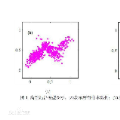Predictive models for marine ecosystems are used for a variety of needs. Due to sparse measurements and limited understanding of the myriad of ocean processes, there is however uncertainty. There is model uncertainty in the parameter values, functional forms with diverse parameterizations, level of complexity needed, and thus in the state fields. We develop a principled Bayesian model learning methodology that allows interpolation in the space of candidate models and discovery of new models, all while estimating state fields and parameter values, as well as the joint probability distributions of all learned quantities. We address the challenges of high-dimensional and multidisciplinary dynamics governed by partial differential equations (PDEs) by using state augmentation and the computationally efficient Gaussian Mixture Model - Dynamically Orthogonal filter. Our innovations include special stochastic parameters to unify candidate models into a single general model and stochastic piecewise function approximations to generate dense candidate model spaces. They allow handling many candidate models, possibly none of which are accurate, and learning elusive unknown functional forms in compatible and embedded models. Our new methodology is generalizable and interpretable and extrapolates out of the space of models to discover new ones. We perform a series of twin experiments based on flows past a seamount coupled with three-to-five component ecosystem models, including flows with chaotic advection. We quantify learning skills, and evaluate convergence and sensitivity to hyper-parameters. Our PDE framework successfully discriminates among model candidates, learns in the absence of prior knowledge by searching in dense function spaces, and updates joint probabilities while capturing non-Gaussian statistics. The parameter values and model formulations that best explain the data are identified.
翻译:海洋生态系统的预测模型用于满足各种需要。由于测量方法稀少,对海洋过程繁多的了解有限,因此存在不确定性。参数值、功能形式和不同参数的功能形式存在模型不确定性,需要的复杂性程度各不相同,因此在州域也是如此。我们开发了有原则的巴伊西亚模型学习方法,允许在候选模型空间内进行内推和发现新模型,所有方法都同时估算了州域和参数值,以及所有学习到的数值的联合概率分布。我们通过使用州级增强和计算高效的非计算高效的高分解混合模型-动态式过滤器。我们的创新包括了特殊的随机参数参数,以便将候选模型统一成单一的一般模型和随机小数函数的近似值,以产生密集的候选模型空间。它们允许处理许多候选模型,可能没有准确的模型,并在兼容和嵌入的模型中学习未知的功能形式。我们的新方法是可概括的、解释的和外推出模型空间的不精确度的不精确度,不精确度是模型的不精确度。我们用模型的模型的模型和模型的模型的精确度更新和精确度更新的模型的模型的模型的模型的模型和模型的模型的模型的精确性,同时用前期算算出,我们用前期的模型的模型的模型的模型的模型的模型的模型的模型的模型的模型的模型的模型的模型的模型的模型的模型的模型和模型的模型的模型的模型的模型的模型的模型的模型的模型的模型的模型的模型的模型的模型的模型的模型的模型的模型的模型的模型的模型的模型的模型的精确性值,可以解释和精确性值,可以解释和模型的模型的模型的模型的模型的模型的模型的模型的模型的模型的模型的模型的模型的模型的模型的模型的模型的模型的模型的模型的模型的模型的模型的模型的模型的模型的模型,可以解释,可以解释,可以解释,可以解释,可以解释,可以解释,可以解释,可以解释的模型的模型的模型的模型的模型的模型的模型的模型的模型的模型的模型的模型的模型的模型的模型的模型的模型的模型的模型的模型的模型的模型的模型的模型的模型的模型的模型的模型的模型的模型的模型的模型



